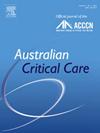A roadmap for applying theoretical frameworks to implementation of hospital rapid response systems: A qualitative study using focus group interviews
IF 2.7
3区 医学
Q2 CRITICAL CARE MEDICINE
引用次数: 0
Abstract
Introduction
Rapid response systems (RRSs) are generally associated with a reduction in adverse events in hospital settings. However, limited attention has been given to the use of effective implementation strategies for successfully embedding the RSS in clinical practice.
Objective
The objective of this study was to identify the barriers and facilitators affecting the reimplementation of the RRS in hospital wards and to develop implementation strategies to address any barriers.
Methods
We conducted a qualitative study using semistructured focus group interviews with nurses and physicians from nine general wards in a university hospital. Identified barriers and facilitators were categorised using the Tailored Implementation for Chronic Diseases checklist. Based on this categorisation, the Effective Practice and Organisation of Care taxonomy was used to develop ward-specific toolkits.
Results
A total of 112 determinants influencing the reimplementation of RRS—both facilitators and barriers—were identified and categorised across all seven domains of the Tailored Implementation for Chronic Diseases checklist. The most frequently cited barriers related to the beliefs and behaviours of individual healthcare professionals. Across all wards, half of the proposed implementation strategies fell into the categories of educational materials and meetings or audit and feedback. The remaining strategies spanned a wider range of categories, tailored to the specific needs of each ward.
Conclusions
This study highlights that effective implementation of an RRS requires consideration of both the behaviour and beliefs of individual healthcare providers, as well as broader organisational issues such as incentives and resources. Successful hospital-wide implementation of an RRS will require a multifaceted approach, combining tailored and educational strategies with components from guideline development and audit and feedback. Further research is needed to determine whether such an approach can lead to successful, sustainable implementation and improved clinical outcomes.
Registration
Not applicable.
应用理论框架实施医院快速反应系统的路线图:使用焦点小组访谈的定性研究
快速反应系统(RRSs)通常与减少医院环境中的不良事件有关。然而,在临床实践中成功嵌入RSS的有效实施策略的使用受到了有限的关注。目的本研究的目的是确定影响在医院病房重新实施RRS的障碍和促进因素,并制定实施策略来解决任何障碍。方法采用半结构化焦点小组访谈法对某大学附属医院9个普通病房的护士和医生进行定性研究。使用慢性病量身定制实施清单对确定的障碍和促进因素进行分类。基于这一分类,有效实践和护理组织分类法被用于开发特定病房的工具包。结果在《慢性病量身定制实施清单》的所有七个领域中,共确定了112个影响重新实施rrs的决定因素(包括促进因素和障碍因素)并进行了分类。最常提到的障碍与个人保健专业人员的信念和行为有关。在所有方面,拟议的执行战略中有一半属于教育材料和会议或审计和反馈的类别。其余的战略涵盖了更广泛的类别,根据每个病房的具体需要量身定制。结论:本研究强调,RRS的有效实施需要考虑个体医疗保健提供者的行为和信念,以及更广泛的组织问题,如激励和资源。在医院范围内成功实施RRS需要多方面的方法,将量身定制的教育战略与指南制定、审计和反馈的组成部分相结合。需要进一步的研究来确定这种方法是否能够成功、可持续地实施并改善临床结果。RegistrationNot适用。
本文章由计算机程序翻译,如有差异,请以英文原文为准。
求助全文
约1分钟内获得全文
求助全文
来源期刊

Australian Critical Care
NURSING-NURSING
CiteScore
4.90
自引率
9.10%
发文量
148
审稿时长
>12 weeks
期刊介绍:
Australian Critical Care is the official journal of the Australian College of Critical Care Nurses (ACCCN). It is a bi-monthly peer-reviewed journal, providing clinically relevant research, reviews and articles of interest to the critical care community. Australian Critical Care publishes peer-reviewed scholarly papers that report research findings, research-based reviews, discussion papers and commentaries which are of interest to an international readership of critical care practitioners, educators, administrators and researchers. Interprofessional articles are welcomed.
 求助内容:
求助内容: 应助结果提醒方式:
应助结果提醒方式:


